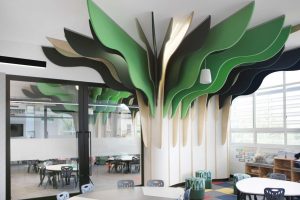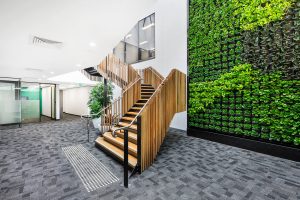What is the latest on lighting?
Mark Perry, design director
To be fair, that’s not the extent of fluorescent lighting’s usefulness in the workplace. And before I go any further, it should be noted that in some circumstances, rows of fluorescent lighting may absolutely be the best solution in a workplace but as a default choice, well let’s just say interior designers can and should do better by their clients.
One of the problems is that return briefs are often dominated (and in many cases, rightly so) by furniture selections, choice of materials, space allocation, colours, form and function – all critical to the effectiveness of the office fit out design. Lighting is sometimes an afterthought except to say, “natural light is good and should be maximised.” Agreed. But before we get to the flouro’s versus LED’s versus downlight debate, let’s first define ‘natural light’.
What is natural light and how can we get some?
Firstly, let’s understand what natural light isn’t. There was a time when bathing an office area (let’s use call centres as an example) with bright, white light for the duration of the work day and beyond was an acceptable substitution for sunlight. Understanding that every square metre of a 100-seat call centre or even a 400m2, CBD, creative hub can’t always be bathed in natural lighting pouring in from floor to ceiling windows, alternatives have been put to good use since the 1950s. These alternatives include the aforementioned, elevated legions of flouro’s, banks of the humble heat-emitting, halogen globe and… that’s about it. The advantage was that every detail, spot or mark on a page, screen or person’s face was easily identifiable to the naked (and by now, sore and watering) eye. As a handy enabler of sleep deprivation, these light sources were ideal however, productivity and quality of work life suffered.
In an attempt to alleviate this suffering and return key personnel to the land of the living from the land of migraines, eye-strain, moodiness, mid-afternoon lethargy and the like, downlights, dimmers and skylights, where possible, were introduced.
But that was then (80s and 90s) and this is now. We’re about two decades into the 21st century so it should come as no surprise that we are thinking differently, exploring new notions and arriving at interesting sources of inspiration. In terms of natural light, that means contemplating more deeply the original and most reliable source of light as far as the known environment is concerned – the sun. The very embodiment and definition of natural light has sat by patiently for countless millennia, waiting for interior designers to arrive at the conclusion that since man has effectively and productively adapted to the sun, any replication of its life-giving rays could/should help create an ideal office environment. I do see the problem though. We can’t bottle sunshine, not yet anyway. We can however, replicate the sun’s effect in the built commercial business environment if we properly recognise what we’re looking at.
Have you seen the light… changing?
From what you’ve already read here and from what you’ve doubtless come to understand about office lighting through experience or from the garnered experiences of others, some hasty and harmful assumptions can be made. There are many but here are just three culprits for consideration:
1. People will stay awake and alert longer if their work is bathed in bright light – just like the sunshine outside.
2. Only moody people become moody at work.It has nothing to do with the lights.
3. The relatively low running costs of banks of commercial fluorescent lighting will benefit the bottom line regardless of the crippling cost of buying “Visine” eyedrops by the pallet-load.
Not to make light of them (moving on… rapidly), but these assumptions have not crippled industries, led the masses to ruin or humbled economies. They have however, made things more difficult than they need to be for those that would spend 6-10 office-bound hours per day trying to maintain or increase productivity.
To be clear, being bathed in white light for hours and hours on end is not helping. Working under various shades, intensities and hues of light is.
How do we know this? Because we as humans have been doing just that since man first set about the task of being productive. Perhaps, that explanation is a bit blithe, but the alternative explanation and more comprehensive explanations includes terms like photoreceptor cells and intrinsically photosensitive retinal ganglia so… blithe it is.
Further, we know that circadian rhythms, the natural biological rhythms of our human bodies that predetermine the secretion of serotonin, melatonin, testosterone etc, take their cue from the detection of changes in light colour and intensity. This is why blanketing staff in white light or yellow light or orange light for hours at a time will do nothing in and of itself to increase productivity. Working with and within the dynamic spectrum and patterns of light that our bodies have been programmed to excel in, is the natural solution.
Having the contacts on hand and the vision to incorporate these solutions into workplace interior designs as a stand alone answer or as part of a hybrid solution is part and parcel of the modern designers creative and practical arsenal. Each client and their respective set of circumstances demands the deployment of various combinations of critical and creative thinking and lighting options are proving every bit as important to productivity as space planning and materials.
As interior design professionals we are tasked with conceiving and creating workplace environments that allow you, our clients, to achieve more and fulfil your brand’s promise. We need to think about what works for the individual and collective alike. This is never an easy proposition but staying on top of research, innovations and developments within and outside of our field helps us to think about and address solutions.
Remember, lighting (fluorescent or otherwise) may not be the problem with productivity but it can be part of the answer. Naturally.




